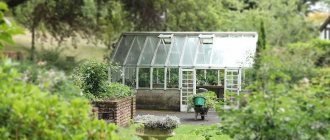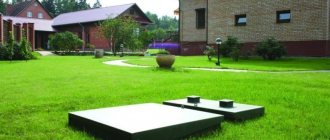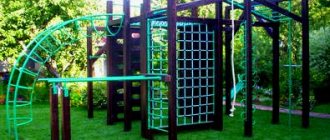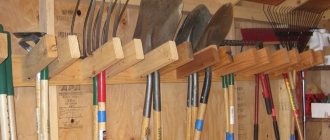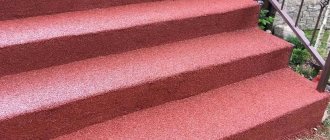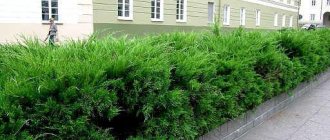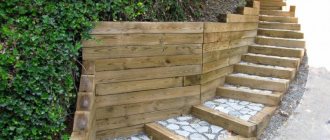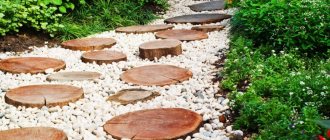A well-organized flower garden along the paths is a favorite technique of professional landscape designers. Used in gardens laid out in a wide variety of styles. You can do it yourself, just organize the planting plan correctly and choose the appropriate type of planting. And in order to avoid serious mistakes, it is recommended to take the advice of the professionals presented in the article.
Rabatka - an elongated flower garden along the path Source sadrium.ru
We arrange flower beds along the paths
Every owner of a suburban area tries to improve it, using popular techniques of landscape designers. One of the favorite techniques is to organize a flower garden along the paths. You can do the landing yourself. Residents of a country house will receive real aesthetic pleasure if the composition is composed correctly.
Twigs and branches
Flower beds in the form of wicker baskets are very popular. They can be purchased ready-made or made yourself. The “handles” give these designs an even more convincing resemblance to basket baskets.
From the vine you can weave an openwork fence for a flower bed. It can be stationary or portable.
Even a non-professional will be able to build a fence for a flower garden from flexible branches horizontally entwining pegs driven into the ground. And even a child can insert thin sticks vertically into the wire frame.
Rules for creating flower borders
Creating a flower bed in a summer cottage is not as easy as it seems at first glance. First, you need to choose suitable plants, and without knowing the intricacies of planting each of them, you will not be able to create a healthy flower garden. The composition will be selected solely according to the desires and capabilities of the gardener. If a person does not have a lot of free time at his disposal, then he simply has no need to come up with complex ornaments.
Alyssum border
Garden paths are designed in the form of ridges, mixborders and borders using a variety of plants. The edges of the tracks can be clearly defined or deliberately blurred. If you want to create clear boundaries, then crops are planted for this, which can be cut with special garden shears. The discount is created from flowers.
The following planting pattern is suitable for a straight path:
To decorate a curved tiled path, it is better to create an elegant mixborder. For this purpose, barberry, juniper, geranium and other crops of bright colors are planted. With the help of such plants it will be possible to create a festive mood in the area for the entire summer season.
If the yard has soft paths made of gravel or other small stones, their design will be successful using ornamental shrubs that can be combined with perennial crops.
Boxwood Buxus border
To avoid many troubles when designing paths on your site, you must adhere to the following tips:
Concrete blocks
It is not easy to get a sufficient amount of natural stone; it is much easier to build a border for a flower bed from leftover building materials. It’s a great idea to use concrete blocks; colored and shaped ones look especially good.
But even from ordinary rectangular blocks you can build an original fence, making it multi-tiered, chaotic, or painted in different colors. The main advantage of block borders is the ability to plant plants right inside, which looks very impressive.
Which plants to choose
Which plants to choose for planting along paths will depend on the size and shape of the site, as well as the wishes of its owner. The main principle that should not be neglected is the equipment of a wide aisle, a competent combination of various crops.
low growing flowers
The list of low plants used to decorate paths in the countryside is quite extensive and for convenience it is better to divide it into several groups:
Crops are also divided into annuals and perennials, which means that the former will need to be renewed annually. Creating the right flower garden is not as easy as it seems. It is worth considering several popular varieties of plants that will decorate the paths of any area:
The listed plants are the most popular when decorating garden paths. They combine all the necessary characteristics and external data to create a truly attractive hedge.
Tall flowers
To make beautiful edges of the path border in the garden, it is better to use plants that reach a height of no more than 50 cm. For example, it is worth considering annual flowers:
Perennials
Perennial plants that are planted along paths have the main advantage of practicality. There is no need to plant at the beginning of each warm season. In addition, there is no need to prepare seeds for next year. Among the popular perennial plants it is worth noting:
Blooming all summer season
Many gardeners decorate a flower bed on their site using lilies, astilbe, and pyrethrum.
Pyrethrum hybrid Robinson Red
Plants are planted in such a way that only flowering crops do not cover those that are already beginning to fade. If part of the path is in the shade, then hosta or astilbe can be planted in this place. This arrangement of plants on the site creates the impression of continuous flowering throughout the summer season.
Source
List of low-growing plants
Colorful landscape of a garden plot with differences in elevation Source www.rutvet.ru
An impressive list of low-growing flowers, thanks to which a beautiful flower bed is organized along the garden path, is conventionally divided into several categories:
- Ground cover.
- Herbaceous.
- Conifers.
- Beautifully blooming.
They can also be perennial or annual, that is, the latter will have to be renewed every spring.
Garden path in combination with plants of different varieties Source www.tsvetnik.info
As an example of the correct organization of a flower bed along a path, let’s consider several different varieties, the use of which will advantageously embellish any flower bed:
- Sedum (sedum) – grows no more than 15 cm in height. Able to withstand serious influences: drought, abundance of moisture, human attack. There are different varieties, differing in size and color of the leaves.
- Scottish moss - does not “rise” above 3 cm. Prefers warm, shaded areas, average watering. It is preferable to plant on the eastern side of the site, where the plant will receive protection from ultraviolet radiation.
- Juniper horizontalis is a slow-growing plant of the coniferous groundcover family. Does not rise above the ground above 4-5 m. The color of the needles in the warm season is silver-blue, in winter - with a purple tint.
- Wild, elfin, and Breckland thyme (creeping) blooms in late May - early June. The shoots, crowned with light purple flowers, do not stretch upward, but spread along the ground, emitting a sweet fragrance.
- Garden chamomile is an unpretentious plant with healing properties. Prefers a cool, dry environment and grows in any type of soil.
- Viola creeping (Loosestrife) – the purple small flowers of the plant harmonize perfectly with paving stones and steps. Creates a strong green frame in early spring, maintaining it until late autumn. Planting this plant as a frame for a flower bed attracts a large number of butterflies.
- Veronica creeping - blooms with blue or white flowers 2-3 times during the summer season. Prefers plenty of sun, but does not die in shaded areas.
Choosing flowers for a flower bed along the path
We will send the material by email
A well-organized flower garden along the paths is a favorite technique of professional landscape designers. Used in gardens laid out in a wide variety of styles. You can do it yourself, just organize the planting plan correctly and choose the appropriate type of planting. And in order to avoid serious mistakes, it is recommended to take the advice of the professionals presented in the article.
Slate and corrugated board
Concluding the topic of construction residues, let’s remember roofing materials and metal sheets. If you have tiles or slates lying around, simply dig these fragments into the ground to the desired depth. It is better to additionally strengthen high slate borders for flower beds from the outside.
Unused corrugated sheeting after erecting a fence on the site can be cut into pieces and also dug into the soil along the border of the flower bed. And if you need to make high flower beds, it is better to strengthen the borders, for example, with a wire frame.
Rules for creating a border of flowers
When creating a flower border next to a path, you should adhere to a number of principles. First of all, this applies to the choice of plants. For example, by planting without taking into account growth, after a while you may end up with an impassable path overgrown with greenery.
To avoid these and other troubles, use these tips:
Advice! Stick to the classic sizes of living flower borders: no more than 500 mm. in width, and 400 mm. in height. However, these conditions can be violated based on the location of application and garden design.
Brick
Now let's turn to the brick. Many owners of self-built private houses still have it in stock, and then it would be an excellent solution to build brick borders for flower beds.
It is not necessary to build a monumental wall; symbolic barriers made of bricks stacked in one line or dug into the ground at an angle also look decent.
What to plant along the path in the country
The choice of plants for the flower garden along the path is made with an eye to the characteristics of the area being improved. It is most rational to use decorative seedlings that are suitable for different areas, regardless of the size and layout of the territory. At the first stage, a planting plan is drawn up taking into account the following factors:
Advice! When creating a flower garden along the path, give preference to plants of different types that differ in flowering periods. Such combinations are called mixborders.
conclusions
- Arranging a border along a path with plants is a good practical and decorative solution.
- When choosing plants, be guided by the requirements for soil, light, care and the amount of time you are willing to devote to the flower garden.
- Pay attention to your goals when creating a border.
- Combine several types of plants: annual and perennial, tall and short, flowering and evergreen. This way you will achieve a decorative look for a long period.
We decorate garden paths and borders. The most beautiful and unpretentious border perennials
Good afternoon, dear friends, gardeners and gardeners! Welcome to the website of the “Country Stories” channel.
The hobby of gardening is becoming increasingly popular. We can no longer limit ourselves to the usual colorful flowerbed. Keen gardeners carefully study the work of professional landscape designers to take note of their techniques.
What is a border flower garden
One of the modern trends in the design of flower beds is border flower beds. Their purpose is to create an edging for a flower bed or lawn; they can surround an object, such as a fountain, or frame a path.
Depending on the style of the garden, the border flower garden can be strict - for classical-style gardens or free-growing - for landscape-style gardens. For a strict border, as a rule, decorative deciduous or flowering shrubs are used, which are regularly pruned. For a free-growing border, perennial or annual flowers and herbaceous plants are used; such a border looks more unruly, “shaggy”.
What plants are suitable for a border flower garden?
As a rule, plants whose height does not exceed 0.5 m or those that tolerate formative pruning are chosen for the border. The width of the border depends on the actual conditions, usually it does not exceed 30-50 cm. The line of the flower bed can be either perfectly flat if it runs along the path, or freely wavy when framing the flower bed. Lawns and fountains are decorated with a circular flower bed.
The border can be multi-level and consist of several parallel lines. Creeping ground cover or bulbous plants are planted in the foreground of such a flower bed, flowering perennials or herbaceous plants are in the background, and a line of trimmed shrubs serves as the third tier.
Borders look beautiful where the plants merge into one continuous mass, and there are no gaps between them. To do this, plants of the same species are planted in two or three rows in a checkerboard pattern.
A border of perennials is significantly superior to a border of annual plants, since it does not require annual planting, and every year such a border becomes better: denser and more lush.
How to choose plants for the border
When choosing plants for the border, you need to pay attention to several important factors:
In order for the plants chosen for the border to show their best qualities and not grow weakened, it is very important to initially select them for real conditions. When choosing, you need to consider three main factors:
We offer you the TOP 10 best perennial plants for the border.
Hosta is one of the best plants for borders. There are a huge variety of hosta species and garden hybrids with varied leaf shapes and colors: from dwarf, 20-25 cm high, to medium-sized, up to 60 cm high. The color of hosta leaves varies significantly. There are varieties with smooth dark green, yellow-green or blue-green leaves, and there are two-color varieties with an uneven border of yellow or white.
Hostas prefer partial shade. It is in light partial shade that the leaves grow larger, juicier and glossier. Only a few types of hosta can grow in full sun, mainly the simple types with green leaves. In an open place, hosta leaves become smaller. But in deep shade the variegated color disappears, returning to simple green. In general, cool-hued hostas (blue-green or matte green with a white edge) prefer partial shade, while warm-hued hostas (bright green or yellow-green) can grow in full sun.
Hostas are undemanding to soil. They can grow on both dense and sandy soils. For harmonious development they need regular watering. But the host does not like stagnant water.
2. Sedum prominent (sedum prominent)
Sedum, or sedum, is a perennial succulent that is highly decorative throughout the entire season: from the moment of growth in early spring, when the plant stems look like amazing unearthly flowers of matte green color, to late autumn, when the bushes that have grown over the summer are covered with lush crimson caps or burgundy inflorescences, up to 25 cm in diameter. Sedum prominent forms dense bushes 40-60 cm high.
There are many varieties of sedum, which differ in the decorativeness of their leaves. In addition to the usual single-color green color, there are varieties with a white or yellow border, as well as varieties whose leaves have a burgundy tint.
Sedum is suitable for growing in open sunny areas. Sedums are not at all demanding on soils; they can grow on both loamy and sandy soils. Sedum does not like stagnant water. If groundwater is close to the groundwater level, it is necessary to arrange drainage. Sedum does not need watering because it accumulates moisture in the thick, fleshy leaves.
3. Stachys, or woolly chist
The woolly chist forms a dense silvery line. Its large leaves are densely covered with pubescence, which gives it a special decorative effect. Because of its shape and pubescence, the plant is called “rabbit ears” or “sheep ears.”
Chistets flowers are inconspicuous; usually the peduncles are cut out. But some are quite decorative.
Stakhis is unpretentious. Grows well in both sun and partial shade. Undemanding to soils. Tolerates drought without losing its decorative appearance.
Lavender is an evergreen subshrub that forms incredibly beautiful borders up to 50-60 cm in height, blooming profusely with lilac spikelets throughout the summer. Lavender responds well to light trimming. The plant prefers light sandy soils, but on dense soils with stagnant water in winter or spring it can become damp. The magical scent of lavender is an added bonus that you get when you plant it along your paths.
The only drawback of this wonderful plant in all respects is its low winter hardiness. Only residents of the southern regions can afford a lavender border.
For residents of the central and northwestern regions, heather is an excellent alternative to lavender. Wide heather borders look no less decorative. In addition, heather is an excellent honey plant; its flowers have a pleasant aroma.
Heather blooms in mid-summer and blooms until frost in various shades of lilac, violet, and ruby. Heather tolerates the Russian winter well. But to successfully grow heather, you need to create certain conditions. Since heather grows naturally on the rocks of Scotland and on the moors, the soil must be poor, light, and acidic. You will have to make a special soil from peat, sand and pine litter. At the same time, heather needs constant moisture.
6. Iris grass-like
The species iris grass-like is not so widely known to gardeners. The appearance of the grass-like iris differs significantly from the bearded iris, which is common in gardens. Its narrow dark green shiny drooping leaves are more reminiscent of the leaves of some kind of cereal; they also look like daylily leaves. The lilac flowers of the iris grass-like do not rise on high peduncles, but open in the green leaves.
The grass-like iris blooms in late May - early June. Flowering continues for 2 weeks. Iris grass flowers have a very pleasant aroma, reminiscent of plum jam.
Iris grass grows wherever you plant it: in the sun or partial shade. Prefers light rocky soils, but is generally undemanding. It tolerates drought easily, and can wither away when water stagnates.
The small daylily is a species daylily, which differs from its varietal counterparts in the small height of the bush, the height of the peduncles does not exceed 50 cm. From the end of May to the beginning of June, the small daylily throws out many lemon-yellow flowers. During the rest of the period, it is a lush border of narrow, long, drooping leaves of a rich green color. Small daylily prefers open sunny places and moist soils.
To create dense, strictly shaped borders, shrubs that lend themselves well to trimming are used.
8. Barberry Thunberg
Barberry Thunberg is the best choice for creating a perennial border. Barberry has a huge variety of varieties that differ in leaf color: yellow, green or burgundy.
Thunberg barberry grows quite quickly. Well formed. With regular pruning, it creates an ideal, dense border due to the abundance of small leaves.
Thunberg barberry is undemanding to growing conditions. It can grow in partial shade, but prefers open sunny places, especially for varieties with purple leaves. Thunberg barberry does not tolerate stagnant water, so a drainage layer is laid on dense soils when planting.
9. Cotoneaster brilliant
Cotoneaster is an excellent alternative to evergreen boxwood, which can only grow in the southern regions and is heavily affected by the boxwood moth. The brilliant cotoneaster forms a border of very high density due to the abundance of thin shoots, densely covered with small shiny leaves of a rich green color. With the arrival of autumn, the color of the foliage changes to yellow-orange.
The brilliant cotoneaster is absolutely unpretentious. It grows in the sun and in partial shade, and on heavy and sandy soils. It is not afraid of humidity, drought or frost. The shoots grow very quickly. Regular pruning is required to keep the border in perfect condition.
10. Japanese spirea
Unlike other types of spirea, Japanese spirea is a very compact cushion-shaped bush, up to 30 cm high, with small foliage on numerous thin shoots. Different varieties of Japanese spirea differ in the color of their leaves. Varieties with gold or orange coloring are especially prized. Japanese spirea blooms throughout the summer, starting in mid-June, with small umbels of small pink, purple or lilac flowers, less often white flowers.
Japanese spirea is an unpretentious shrub. It can grow in partial shade, but blooms more luxuriantly in the sun. It is undemanding to soil, but develops better on light, fertile soils.
The list could go on. In addition, we did not touch upon annual plants. Surely, you also have favorite plants to create beautiful borders.
Source
Logs and stakes
Continuing the theme of logs, we will cut off identical side fragments from them and line them up on the border of the flowerbed. The bark can be whitened to make it more attractive.
Old logs look very picturesque, laid entirely along the edges of the flower bed. Young birch trunks cut in half also make a beautiful border for a flower bed.
A massive stump or a huge long log can independently play the role of a flower garden.
You can make a curb from rounded logs according to the same principle as is used in the construction of log houses.
Finally, planed stakes can be easily turned into a hedge for a flower bed by digging them into the ground to different or equal depths.
Flowers for the border along the paths: purpose
How to beautifully plant flowers along the path? To highlight the regular or bizarre shape of a ridge or flower bed, low-growing crops are used in the border design, which cannot hide other elements of the garden, for example, architectural compositions or topiary.
Landscape design using shrubs
The main selection criterion is the compact shape. In addition, the flowers should be lush so that no gaps are visible. Only in this case will the border be spectacular. The edging can be designed in the form of irregular geometric shapes or patterns.
Low flowers for borders include numerous species and varieties, so it's easy to choose green plants to suit your garden style. When decorating borders with flowers, the following are most often used:
For your information! If children often play in the garden, then it is better to choose trampling-resistant greens for planting. Areas adjacent to playgrounds, lawns and paths are often subject to mechanical damage.
To emphasize the beauty of landscape design and decorate the local area, plants are used for edging:
Flowers for borders along paths should have a long flowering period.
To design a mini-hedge, you need to select decorative or flowering crops in accordance with the type of soil, location of the site, and taking into account the climatic conditions of the area. After all, the final version should look like a single whole and be in harmony with the environment.
Flowers for the border along the paths
Annual, biennial and perennial flowers and shrubs are used to create flowering or decorative borders. In order not to make a mistake with your choice, you need to remember the main rule: plants in the border design must create a dense carpet, otherwise the planned design will not be effective. When planting, plants are placed closer to each other so as not to wait a long time for them to grow and fill the space. In order for the border to look beautiful and the border to catch your eye from afar, there should be no voids or wilted plants.
Tiles and mosaics
The blocks can be additionally decorated with mosaics. To do this, they are covered with mortar, shards of tiles or pieces of colored glass are pressed into it and wait for it to harden.
Or you can simply lay out the border for the flower bed with interesting tiles, purchased specifically for this purpose or left over after renovation.
Low-growing flowers for the border, annuals and biennials
The main advantage of annual flowers over perennials is that there are so many varieties among them that every year you can create an original design that is not repeated from year to year.
Annual plants for border decoration
Annual flowers for borders along paths have their advantages:
1. By combining several varieties, you can create a colorful flowerbed to frame a tree on your lawn.
2. Acceptable cost of seedlings. This plays a big role, especially when the borders are long and you will need to buy many copies.
3. Flowering paths look decorative throughout the warm season, right up to the onset of frost.
4. Every year you can create new compositions from different varieties of plants.
Among the disadvantages of annuals for decorating borders are the labor costs: every year you have to sow seeds for seedlings, pick and plant them.
To make your work easier and avoid sowing seeds at home and subsequently caring for the seedlings, you can buy flowers whose seeds can be planted directly into the ground, without seedlings. These are marigolds, lobularia and calendula.
In order to save the family budget, you can grow seedlings yourself. Depending on the variety and climatic conditions of the area, sowing seeds for seedlings is carried out in January-March. Seedlings can be bought ready-made.
The following are often used in border decoration: purslane, low-growing marigold, allisum, zinnia, and Chinese aster.
You can plant annual crops that continue to bloom until frost. Preference should be given to:
Marigold
Thanks to their ease of care, long-lasting and abundant flowering, marigolds occupy a leading position in popularity in the design of borders along paths. I'm pleased with the length of flowering. In June, red, burgundy, orange, yellow, and lemon flowers appear. Flowering can only be interrupted by frost.
Marigold
For cultivation, it is advisable to choose low-growing varieties with a stem height of no more than 30 cm. However, the rich, bitter aroma of flowers is not suitable for everyone. In this case, the planting can be taken away from the house and used to decorate the area near the fence or used as an edging for the border.
Everblooming begonia
To design paths you need to choose low varieties. Begonia blooms in June and fades in October. All this time it pleases the eye with red, salmon, white, orange, yellow flowers. The main advantage of the species is the ease of growing seedlings. Begonia everblooming is especially beautiful in perimeter plantings and for delineating borders.
Begonia
Balsam
Annual plant. During the growing season, the height of low-growing bushes does not exceed 15 cm. Long-term flowering with simple and double flowers, sometimes two-colored. Impatiens tolerate light shade, so balsam can be planted in the partial shade of the garden. Impatiens are also suitable for planting along the edge of the lawn.
Balsam
Ageratum or longflower
In its natural growing environment, ageratum is considered a perennial plant; in our conditions, it can only be grown as an annual crop. The height is 25-30 cm. In early June, white or purple ageratum flowers bloom above the green mass. Flowering continues until frost. As it grows, it creates a dense carpet, which is why the long-flowered plant is popular in border decoration.
Flowers for the border along paths Ageratum
Salvia splendor or salvia
The decorative fire plant reaches 25 cm in height. Does well in a sunny area. Red salvia is the most popular variety. You can move away from the canons and grow sage in other shades: purple, salmon, white. The border biennial blooms in June. Blooms all summer and autumn.
Salvia
Flowers for the border, low-growing biennials
Growing biennial flowers takes a lot of time: first you need to sow the seeds, grow the seedlings and plant them in a permanent place. There will be no flowering in the first year. Only in the second year after planting can you admire the flowering. It is preferable to plant pansies, forget-me-nots, chamomile or lacfiole.
Decorative cabbage
The biennial plant reaches a height of 30 cm. A notable feature of the crop is its multi-colored rosette, the coloring of which occurs at low temperatures. It is especially decorative in autumn and decorates the garden at the beginning of winter.
Decorative cabbage
The leaves have a wide color palette; they can be yellow, violet, red, purple, rich light green, white and cream. What’s remarkable is that this entire range of colors can be simultaneously present on one copy.
Looks great in the design of low borders and flower beds. Good in combination with other annual or perennial plants.
Pansies
The herbaceous perennial plant is popular in edging paths or used to create borders. But the Wittrock violet will only act as a spectacular plant and look beautiful if seedlings of the same variety are planted in one row. Viola is easy to grow and can withstand light trampling. Flowering lasts from March to October.
Pansies
Daisies
Depending on the variety, daisies grow to a height of 4 to 20 cm. Flowering in a two-year-old plant is observed in the 2nd year.
Daisies
It is important to know! An interesting feature of the crop is the variability of its growth. The daisy adapts to the specific conditions in which it grows. For example, if it has settled on the lawn, the flowers will bloom on short stems so that they cannot be cut off by a lawn mower.
The bladed leaves are collected in a rosette. Thanks to breeding work, many varieties with red, orange, pink, white, and multi-colored flowers have been developed. The daisy is the queen of the garden, just like the rose.
Tall flowers
A winding path bordered by rich greenery Source www.botanichka.ru
For floral edging of the border of a garden path, plants with a height not exceeding 40-50 cm are used. As an example, consider options for using annual representatives of this group:
- Ageratum Houston (Mexican) is a heat-loving variety, planted after the threat of night frosts has passed. The plant blooms in lush baskets of small flowers in pink, blue, and purple shades. Creates a lush surface, the height of which is adjusted by pruning the shoots. Recovers in a few days. It blooms in early June and remains in this fragrant state until the first frost.
- Salvia (sage) - the flower reaches a height of up to 50 cm. For border frames, low-growing varieties are used: “Fireball”, “Vesuvius”. It is grown only through seedlings. The bright red flowers of the plant harmonize perfectly with the miniature yellow leaves of marigolds or silvery ciniririums.
Beautiful perennials Source flo.discus-club.ru
- Hybrid nasturtium - the plant will decorate the landscape design of the garden not only with voluminous, rich flowers of light yellow or fiery red, but also with original leaves. Large, rounded, suspended cuttings look impressive. To decorate the border of a flower bed, bush varieties are used: “Strawberries with Cream” and “Jewel Mix”; species with unusual variegated leaves are also used: “Alaska Golden”, “Alaska Scarlett”.
- Coreopsis - yellow, orange or golden flowers on a thin stalk can be planted in open ground. For this purpose, the Crimson King variety is used, reaching a height of 30 cm.
Advantages and disadvantages of perennial flowers
An undeniable advantage of perennial crops in the design of borders is the ability to be restored annually. I worked hard once and forgot.
One of the significant disadvantages is short flowering in comparison with annuals and biennials.
Perennial flowers and shrubs, popular among summer residents
In landscape design, flowers often used for borders along paths are perennials:
You can choose cultivated aubrietta, low-growing chrysanthemums, dicentra, creeping tenacious, gray-blue carnations.
Of the perennial shrubs, you should pay attention to euonymus and lavender. In order for borders to look compact and decorative throughout the season, it is recommended to carry out timely pruning. A long-term option is to plant boxwood or low-growing barberries. Varieties have varieties with multi-colored leaves, which enhances their decorative qualities.
feathery carnation
The height of the low-growing crop reaches 30 cm. The narrow blue-green leaves of the carnation, collected in a bunch, look beautiful. In May, the plant is covered with pink or white flowers. Does not like waterlogged soil.
Narcissus
Popular bulbous plant. When creating borders, one must take into account the fact that daffodils bloom in the spring, then the green mass dies. The height of individual varieties ranges from 25 to 40 cm. It blooms with orange, yellow, and white flowers. You can find two-color varieties.
Narcissus
Khosta
An ideal plant for borders. You need to choose low-growing varieties. Hosta is good because it can grow in the shade, so it is considered a good option for decorating shady corners of the garden.
Perennial flowers popular among summer residents
Sedum prominent
The sedum, or, as it is called, the ice plant, reaches a height of 40 cm during flowering. Oval leaves with jagged edges sit on thick shoots. Flowering occurs in the second half of summer and continues in autumn. The flowers are pink.
Sedum prominent
Lavender
Suitable for planting in Provence style gardens. Perennial flowers for borders are considered the most beautiful. They can be used to decorate areas near paths.
Lavender
Purple and lilac lavender flowers enchant with their tenderness and pleasant aroma. In July-August there is abundant flowering. The height of the plant is 0.6 m. There are varieties with high resistance to frost.
Lavender thrives in sunny areas protected from gusty winds. Grows best on slightly alkaline soil, air- and water-permeable.
Small-flowered heuchera
The evergreen perennial crop is planted in high ridges; the surface can be decorated with heuchera. The height of the plant is 0.6 m. Paniculate inflorescences with small pink or cream flowers bloom above the beautiful foliage. The advantages of heuchera are its curly leaves, colored purple or green.
Heuchera
Heather
The plant blooms from July to October. The flowers look like cups with curved leaves. They are located at an angle in relation to the stem. It is better to plant the crop in several copies so that they have a natural appearance. Depending on the variety, red, white, purple, and pink flowers bloom.
Perennial flowers, heather
Planting of the bush should be done in a bright sunny place. It should be noted that plants prefer acidic soil and do not tolerate excessive moisture. Despite the fact that heathers are considered frost-resistant, it is recommended to cover young seedlings with agrofibre. To maintain decorativeness, regular pruning is necessary, which is carried out after flowering, cutting off the shoots below the peduncles.
Bloodroot
It is advisable to design in one tone, that is, plant varieties with either red, white or yellow flowers next to them. The height of the plant is 1 m.
Bloodroot
In June, orange, light red, white or yellow flowers appear above the silver-green foliage. It gained popularity due to its resistance to low temperatures, diseases and pests, and soil. Tolerates drought well. Needs regular pruning. In spring, it is necessary to remove all damaged, frozen, dry and diseased shoots.
Erika
A notable feature of the plant is its flowering time - February-April. At this time, pitchers bloom on the bush. The leaf blades look like needles and are located perpendicular to the stems. Grows well in slightly acidic soils, moderately moist with good air permeability. Can be successfully grown in sunny areas or in partial shade.
Erika
Japanese spirea
Frost-resistant shrub. Not susceptible to diseases and pests. Leaves are the pride of Japanese spirea. Depending on the season, the sharp oblong foliage changes color. The height of the crop is 1 m. Flowering begins in June and continues until September. It blooms with small white or pink flowers collected in clusters.
Japanese spirea
The shrub grows well in fertile soil. The ideal planting option is a bright place, but it will not disappear in partial shade either. Pruning should be done in spring. Does not react to air pollution, is resistant to frost and pests, and temporary heat.
The plants described will help you decide what flowers to plant along the paths: perennials , annuals or biennial crops; you can opt for shrubs.
Perennials
A bench on a garden path framed by greenery Source www.botanichka.ru
The main advantage of perennial plants in their use to create a flower garden along the path is practicality. They do not have to be planted at the beginning of each season, trembling before the start of the growing season, and preparing seeds for the next year in the fall.
- Sedum Vidny - during the flowering period reaches a height of 40 cm. It grows in abundant shoots on a thick stalk. The top is crowned with pink flowers that do not fade from the beginning of August to the end of September. It is unpretentious to soil and watering. It grows both in the shade and in well-lit areas.
- Heuchera small-flowered - the plant is used in border framing and filling high edgings. An evergreen perennial with large green or dark purple leaves extending no higher than 15-20 cm above the soil. The flower joints rise on a long, rigid stalk, holding small cream or pink flowers.
- Narcissus - used for early decoration. The bulbous plant blooms in mid-April, retaining its petals until the May holidays. It is found with snow-white or yellow petals with a golden stamen. It is unpretentious to soil and grows well both in the shade and in the sun. However, in warmer areas, where the snow melts first, it rises faster.
Asphalt path with flower beds instead of borders Source flo.discus-club.ru
- Lavender - fluffy, fragrant bushes are popular among herbalists who prefer natural tea. Bright purple spikelets in the border of a garden path look impressive, but require regular care. Growing will require periodic loosening of the soil, regular watering, fertilization, and preparation for winter. The plant also prefers sunny, draft-free places and vapor-permeable soils saturated with an alkaline reaction.
- Cinquefoil (shrub cinquefoil) - the plant is used to create a flower border in white, yellow or red. It does not exceed 1 m in height. It blooms at the end of May, retaining the inflorescences until the first frost. It tolerates frosts in central Russia well and is not susceptible to pests, drought, or soil conditions. Care is required only in spring: dry, weak shoots are pruned in March-April.
- Mussolini's catnip is an ideal option for rocky, infertile soil. It blooms on any side, but the maximum effect of the inflorescences is achieved where they are heated by the sun's rays. It does not exceed 40 cm in height, has an original blue-lilac hue, and blooms throughout the summer season.
Original landscape design Source happymodern.ru
Important! A significant disadvantage of perennial plants in flower beds along paths is their short flowering period compared to annuals.
Landscape Design Rules
Most of the area in a dacha or personal plot is occupied by a garden and a vegetable garden. But there isn’t much space left for a flowerbed. Usually this is a small area near the house and a place along the fence. To make the space along the fence look impressive and beautiful, you need knowledge about the principles of design of flower beds and flower beds.
First, it is important to decide how many meters you can allocate for a flower bed along the fence. If the fence is long and the plot of land there is wide enough, then the choice of plants is unlimited. But when there is little space at the dacha, every meter is taken into account, then flowers and shrubs are selected in small sizes.
It is necessary to plant plants that have the same requirements for soil, watering, and sunlight. When choosing seedlings, take into account which side the fence is located on (in the sun or in the shade).
There are many types of fencing for the area along which plants are planted: from picket fence, wood (boards), chain-link mesh, corrugated board, brick or slate. The choice when planting green spaces is also influenced by the height of the fence, the heating properties of the material, etc.
When plants are planted in the southern part of the site, the choice is made of drought-resistant crops that require a large amount of sunlight for full development. The soil here will need to be watered much more often. Therefore, in such a flowerbed there is no place for flowers that require abundant watering.
In the northern part of the farmstead, cold-resistant plants are planted that are not afraid of strong winds. You can plant a hosta near the fence or build an alpine hill with coniferous crops, for example, fern and horizontal juniper.
This will be useful to you: Secrets of proper cultivation and care of shadberry
Lupines have absorbed all the colors of the rainbow
I grew them. We liked them for their unpretentiousness and appearance. They grow into lush bushes. The foliage is beautiful, openwork.
Lupins by the fence
There are a lot of advantages. The seeds are large, sowed directly into the ground. Lupine, a member of the legume family, also enriches the earth with natural nitrogen. There is no color of the rainbow that is not found among lupins: red, yellow, blue, blue, orange, and also pink, white, lilac, violet.
There are also disadvantages:
- They grow quickly both by root and by self-sowing. Old bushes bloom worse; they need to be divided and replanted.
- There were cases that in the spring lupine did not grow back from the old root, or frail branches grew, and there were no flowers.
- They bloom for a short time - 3 weeks in May or June.
- After flowering they look ugly; instead of buds, beans with seeds appear and turn yellow. You need to cut off the flower stalks.
But I already miss lupins and want to plant them again?
The flower is not picky about soil, but grows better on moderately moist soil, without stagnant water. Loves sunny places.
Selecting plants for the type of fence
The material from which the fence is made also affects planting.
Wooden fence
Wood is a natural material that goes perfectly with greenery and flowers. So no matter what you plant, the results will be attractive. Usually bushes or tall flowers are placed along them - unpretentious mallow, sunflower. If the stakes are rare, take a closer look at the vines - girlish grapes, for example, grow quickly and will curl around the boards amazingly.
The photo shows a mix of decorative and deciduous trees
Rabitz
Choose the material for planting depending on your purpose - to hide or decorate. To hide, it is enough to plant tall trees or bushes along the fence on the side of the street and yard. They will simultaneously hide the unsightly mesh and you from curious passers-by.
You can decorate the net with various creepers: fast-growing clematis, annual kobeya or nasturtium, perennial ivy, grapes, hops.
The photo shows an example of using bushes near the grid
Corrugated sheet/profiled sheet
A blank fence made of corrugated sheets does not need additional insulation, so low bushes are planted along it or bright flower beds are laid out.
But before planting, check how the fence regulates sunlight: a galvanized sheet, for example, will reflect it and the plants will simply burn in the sun. Dark, on the contrary, conceals and creates a shadow, which is also not always good, and also becomes very hot.
Also avoid thorny bushes and flowers - they can scratch the fence in the wind, ruining its appearance.
The photo shows trimmed thujas
Wrought iron fence
Everything that happens inside can be seen from the street, which means you need to take care of the aesthetic “underside.” A mixed border, for example, should not be pressed against the fence with its high side (unless you want to hide from your neighbors). It is better to make it double-sided - so that the high part is in the center, and lower levels extend from it towards the house and the fence.
The photo shows a variant of a high flower bed
Brick fence
The brick structure is dense, not allowing the sun and air to pass through. Blue spruces, thujas, and cedars look good along it. Hostas, ferns, phlox, and dicentras will feel good in the shade of the fence.
The photo shows a combination of tall and low seedlings on the site
Types of flower beds for decoration
Annual plants grown with your own hands will help you quickly and inexpensively update your design, create a new mood, a colorful impression, and cause slight envy among passers-by and neighbors. Decorating flower beds is a special type of art, for which inspiration is not enough.
Variety of decorative options
A flower bed is a separate type of garden art, which has become especially widespread among those who try to use their own land ownership not only for utilitarian purposes.
Those who strive for independent creativity, decorativeness and creating a general impression want to make a flowerbed, occupying a minimum area, but creating the most impressive impression.
Flowerbed along the house
Of no small importance is the design of decorative structures, with the help of which you can enhance or smooth out the advantages and disadvantages of imperfect relief. A rationally planned area can be given individual characteristics using non-traditional decorative elements in garden splendor.
The variety of invented flower beds that can be placed in a dacha, grown in a previously unused area in the shade or placed on a fence is always a pleasure to capture in a photo. Even if a lot of time was spent creating this beauty, the result is worth it.
The photo shows a beautiful flower garden.
Flowerbed along the hedge
Purpose
Flower beds along the fence are multi-purpose and versatile structures. When designing a decorative component with your own hands, you don’t need to be afraid to show your imagination, carry out costly work, or create structures from stone or auxiliary materials.
Placing flower beds near the fence allows you to hide the imperfections of the fence
Thoughtful design will help:
- Disguise an unaesthetic hedge along the fence;
- close what is happening on the territory from prying neighbors' eyes;
- continue the registration of zoning or vegetation near the house;
- just add beauty to everyday life and please the eye;
- transform strips of land along the demarcation line into beautiful and cozy corners or flower plantings;
- create a single and complete image of the entire available space;
- create a soft stylistic transition from the site to a boring fence;
- just save land for gardening by creating a flower bed under the fence so you can see it from the windows of the house.
bush fence
An alternative to standard fencing and an incredibly effective one would be to create a bush fence at your dacha. It turns out that there are two in one: a flowerbed and a fence. When planting a living fence of shrubs, first determine its purpose.
- Aesthetic function. Flowering shrubs will create a chic appearance for the fence: jasmine, lilac, barberry, viburnum, spirea, hydrangea and others. The flowering time of shrub crops varies: from mid-spring to mid-summer. If you create compositions from different types of plants, you can form a continuously flowering hedge.
- Advice! It is better to select shrubs with the same type of leaves and the same height, but with different flowering periods. Lush and tall bushes do a good job of protecting.
- Function: impenetrable and thorny fence. To make penetration into the area as difficult as possible, thorny bushes are used: tea rose, rose hip, blackthorn, gooseberry, hawthorn.
- Function – the fence is evergreen and living. A fence made of evergreen shrubs can decorate and at the same time protect a site at any time of the year. Evergreen crops include: heather, thuja, erica, juniper.
Bush fence height
- Low fence. To create a low hedge (up to 50-60 cm), shrubs are planted: gooseberries, boxwood, artisanal cinquefoil, alpine currant, yellow acacia.
- Living fence up to three meters. Shrubs suitable for hedges are: lilac, thuja, rose hips, hornbeam, juniper.
- A fence made of tall (from three meters) bushes. A high fence will be obtained by planting the following shrubs: hawthorn, yew, dogwood, western thuja, and common hornbeam.
When planting plants, consider:
- compatibility with other shrubs;
- flowering time;
- unpretentiousness when growing;
- ease of pruning and crown formation;
- growth rate.
A well-maintained living fence at the dacha will be the hallmark of the site. Caring for a bush fence involves fertilizing the plants, trimming and watering. Seedlings for planting are chosen especially carefully, since all the bushes must grow together, creating the integrity and beauty of the fence.
It is important to trim the bushes regularly, this will keep the fence in excellent condition. Even when the crown grows freely, this does not mean that the plants do not require pruning. Regular pruning will make the bushes denser, the bushes will bloom more abundantly and luxuriantly, which is important for a living fence.
Phlox paniculata - a beautiful classic
There is nothing easier than growing phlox. And they bloom for a long time: on my site they show off from July to September.
This is my first old phlox. I dug up a root for planting from my mother’s garden.
My phlox paniculata without a name
Last year I bought the pink variety Graf Zeppelin. It was already blooming the year it was planted.
Phlox Graf Zeppelin against the background of tarragon
Phlox grows by rhizomes. 3-4 years after planting, the bush can already be divided into several seedlings.
I don’t really take care of it in any way, except for the field.
Phloxes by the fence
The best place for planting is open to the sun, but hidden in the hot afternoon hours by a tree or fence. The soil should be moist.
Composition from driftwood
Wood in any form in flower beds looks both natural and impressive. Even when these are untreated stumps or snags.
It’s easy and simple to adapt driftwood to a flower garden. First, a fence is created, and then only the plants are planted in the prepared soil. Driftwood, crooked trunks, and thick branches are laid out along the perimeter. Before laying, they are cleared of bark and treated with an antiseptic. The driftwood must be laid so that the soil does not wash out during rain.
Stone structures
Small decorative stone fencing is created with your own hands from the following building materials:
- natural stone;
- different colors and types of bricks;
- materials based on concrete mortar.
When selecting material for fencing, soil characteristics are taken into account. If the flower garden is located on uneven ground, it is better to use a brick or stone for the border. If the surface on the site is flat, then medium-sized natural stones are used for the border structure. Concrete structures are suitable for all types of terrain.
Stone
High or low, laid out in a creative disorder or pebble to pebble, borders made of natural untreated stone always look impressive. Thanks to them, the illusion of a mountain clearing is created, where rock cliffs cover an alpine meadow. And simple pebbles can be turned into a border by beautifully laying them along the border of the flower bed.
There are many options for creating a stone fence; you can use both raw stones with torn edges, smooth boulders, and polished bricks made of marble or granite.
Usually the stones are held together with cement mortar, and if the structure is very massive, then reinforcement is used for strengthening. A lot of design projects have already been invented - you can take a ready-made version and implement it in your dacha. The simplest solution is to lay a low fence made of small stones around the perimeter of the flowerbed. Complex projects involve creating a rock garden, rock garden or raised flower garden.
After laying the stone, pebbles are laid around the flower bed, which emphasizes the stone or other material. The flower beds, which are lined with a mosaic of multi-colored pebbles along the edges, look original. Such borders can be organically redirected into a garden path.
Brick
Brick fencing is modern and durable. This flower fence will last a long time, giving the flower garden a beautiful and well-groomed appearance. There are many solutions for laying bricks. A simple option is to install bricks flat in the pit at a depth of 5-7 cm.
Using bricks, high slides of 5-10 steps are created. The brick border protects the flower bed from spreading and participates in the formation of the contours of the paths. To lay the brick, use cement mortar or lay the material on a dry mixture of sand and cement.
Brick is a building material that is resistant to negative external influences, withstands rain, frost, shock and loads.
Concrete
Concrete curbs come in a huge variety! You can create it yourself or buy ready-made samples. Design projects for concrete fencing are striking in both shapes and colors. These can be blocks, bowls, high openwork fences, or low solid borders.
Concrete fences for plants have several advantages:
- attractiveness, style, exclusive solution;
- suitable for any style of landscape design;
- imitation of various natural rocks;
- reliable protection of the flower bed from the growth of plants and roots;
- the use of concrete fences to design winding paths, along the edges of which ribbons of different plants are mounted;
- zoning of the space adjacent to the house, garden;
- can be created easily with your own hands, without large financial investments.
Designs in a rustic style, in a country style, are usually made in terracotta, dark green, dark brown tones. Wood and stones are used to create a border.
Goldenrod is aggressive! be careful
I really liked it in the picture, I really wanted to plant it.
Actually, I don’t like yellow in flowers, but here it’s just fluffy gold.
It is grown from seeds by sowing in the ground or through seedlings. In our store I found varieties Josephine and Golden Arrows. Used to create hedges, suitable for winter bouquets. Blooms from late July, August and September.
Goldenrod prefers sunny and partial shade, as well as moist soil.
Do not confuse the invasive wild species with Giant Goldenrod. We are talking about cultivated varietal goldenrod, bred by breeders.
Goldenrod was tamed and abandoned
Mixborders: photo ideas
Recently, landscape design along the fence has been organized using mixborders. These are plantings that are very diverse and bloom at different times. Thanks to these properties, mixborders look beautiful at any time of the year.
Flower arrangements can include not only low-growing plants, but also shrubs, fruit trees, climbing vines and other garden inhabitants.
When organizing this type of flower bed, the owner of the dacha must choose the plants correctly.
A landscape designer who knows the characteristics of each plant and its compatibility with its neighbors will help you cope with this. Source pinterest.com
Shrubs and trees along the fence
Very often, summer residents place trees and shrubs along the fence.
Trees and shrubs along the fence Source gardencreator.net The most unpretentious of trees: mountain ash, hawthorn, fir, pine Source samstroy.com
When planting tall seedlings, their growth should be taken into account, so they are planted at a distance of 3-5 meters from the house, otherwise they can damage the foundation of the building.
More often, dogwood, elderberry, hydrangea, and dogwood bushes are located next to the fence. When planting the latter, take into account that it does not get along with barberry.
On the outside of the fence, it is customary to plant decorative species of shrubs that can create a hedge.
These can be rose hips, viburnum, bird cherry bushes Source wallpaperup.com
